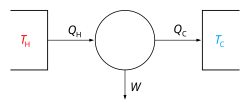
Back حجم دراسي Arabic Volum de control Catalan Volumen de control Spanish حجم کنترل Persian נפח בקרה HE 検査体積 Japanese 검사 체적 Korean Volume de controle Portuguese Volum de control Romanian Kontrollvolym Swedish
| Thermodynamics |
|---|
 |
In continuum mechanics and thermodynamics, a control volume (CV) is a mathematical abstraction employed in the process of creating mathematical models of physical processes. In an inertial frame of reference, it is a fictitious region of a given volume fixed in space or moving with constant flow velocity through which the continuuum (a continuous medium such as gas, liquid or solid) flows. The closed surface enclosing the region is referred to as the control surface.[1]
At steady state, a control volume can be thought of as an arbitrary volume in which the mass of the continuum remains constant. As a continuum moves through the control volume, the mass entering the control volume is equal to the mass leaving the control volume. At steady state, and in the absence of work and heat transfer, the energy within the control volume remains constant. It is analogous to the classical mechanics concept of the free body diagram.
- ^ G.J. Van Wylen and R.E. Sonntag (1985), Fundamentals of Classical Thermodynamics, Section 2.1 (3rd edition), John Wiley & Sons, Inc., New York ISBN 0-471-82933-1
© MMXXIII Rich X Search. We shall prevail. All rights reserved. Rich X Search














